
Methuen is a city in Essex County, Massachusetts, United States. The population was 53,059 at the 2020 census. Methuen lies along the northwestern edge of Essex County, just east of Middlesex County and just south of Rockingham County, New Hampshire. The city is bordered by Haverhill to the northeast, North Andover to the southeast, Lawrence and West Andover to the south, Dracut to the west, Pelham, New Hampshire to the northwest, and Salem, New Hampshire to the north. Methuen is located 17 miles (27 km) southwest from Newburyport, 30 miles (48 km) north-northwest of Boston and 25 miles (40 km) south-southeast of Manchester, New Hampshire.
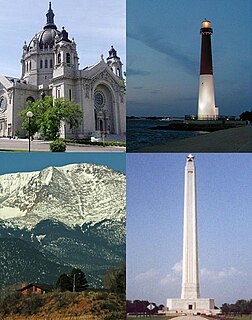
The U.S. National Register of Historic Places (NRHP) classifies its listings by various types of properties. Listed properties generally fall into one of five categories, though there are special considerations for other types of properties which do not fit into these five broad categories or fit into more specialized subcategories. The five general categories for NRHP properties are: building, district, object, site, and structure.

The Capt. Oliver Emerson Homestead is a historic house at 133 North Street in Methuen, Massachusetts. The 2+1⁄2-story wood-frame house was built c. 1775 by Oliver Emerson, a locally notable leader of American Revolutionary War forces. The house is built on a rubble foundation, and features a large central chimney that is typical of Georgian houses. It is located on one Methuen's early roads, and is one of a few remaining houses that predate the height of the city's development in the mid 19th century.
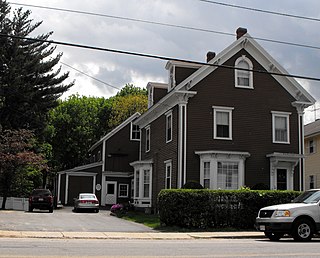
The house at 50 Pelham Street in Methuen, Massachusetts is a well-preserved Italianate house and barn. Built sometime in the 1870s, the 2+1⁄2-story wood-frame house features typical Italianate decorations, including extended bracketed eaves, doubled brackets in the gable eaves, and a round-arch window in the gable end. The barn at the back of the property is a simple wood-frame structure that appears to date to the same period as the house.

The House at 491 Prospect Street in Methuen, Massachusetts is locally significant as an excellent example of a Shingle Style house of the type built for well-to-do businessmen in Methuen and Lawrence around the turn of the 20th century. The three story wood-frame building was built c. 1900. One of its principal decorative features at the time of its listing on the National Register of Historic Places in 1984 was a Palladian window in the gable, around which square-cut shingles had been arranged in a keystone motif. This detail has since been lost due to the application of new siding.

The House at 306 Broadway in Methuen, Massachusetts is a well-preserved example of a modest Greek Revival house built c. 1830. It is of a type that was somewhat common in Methuen from the 1830s to the 1850s. It is a 1+1⁄2-story wood-frame structure with its gable end facing the street, but its entry centered on the long side wall. The front was originally three asymmetrically located windows, but this has since been replaced by a virtual wall of five windows. The corners of the house are pilastered in typical Greek Revival fashion, and the gable end has a deep cornice. The main entrance is centered on the five-bay side wall, and features a transom window over the door.

13 Annis Street is a historic mill worker house in Methuen, Massachusetts. Built about 1880, it is a typical small residence built for workers at the nearby Arlington Mills. It was added to the National Register of Historic Places in 1984, but has lost many of its exterior decorative details since.
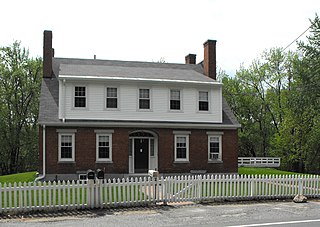
Old Town Farm is a historic poor farm building in Methuen, Massachusetts. The brick two story building was built in 1846, after Methuen lost its earlier poor farm due to the loss of part of its territory to newly founded Lawrence. The building is five bays wide and deep, with entries on the front and side; the front entrance is recessed with a fanlight and sidelights. The building has shed dormers that run much of the length of the roofline, and its end walls are topped by parapets and double chimneys, features not seen elsewhere in the town.

Park Lodge is a historic house in Methuen, Massachusetts. It is primarily noted for its association with industrialist and philanthropist Edward Searles whose Pine Lodge estate was nearby. Searles, a Methuen native who made a fortune in textiles and the railroad, made major contributions to the development of Methuen around the turn of the 20th century. This Craftsman style house, designed by Henry Vaughan and built in 1910, is a notable architectural element of Searles' legacy. The main block is a 2+1⁄2-story structure with a side-gable roof, which is extended to the left by a 1+1⁄2-story ell and to the front by a two-story projection. A shed-roof porch is in the crook to the left of this projection, and the main entrance is in the leftmost ell. The house is generally finished in stucco, with wooden shingles in the gable ends.

The Joseph Perkins House is a historic house in Methuen, Massachusetts. From its external appearance, it is a Greek Revival 1.5-story wood-frame house, which appears to have been built around 1840; however, it has also been assigned construction dates as early as 1752 by local historians. It exhibits Greek Revival features, with corner pilasters, a deep cornice, and a center delighted doorway framed by an entablature supported by pilastered. It is named for a farmer who owned the property in the 19th century.

The Tenney Castle Gatehouse is a historic gatehouse at 37 Pleasant Street in Methuen, Massachusetts, United States. It was added to the National Register of Historic Places on January 20, 1984. It is the only surviving element of the large estate of Charles H. Tenney, a leading local industrialist.

The Charles Schuebeler House is a historic house in Somerville, Massachusetts. The 2+1⁄2-story wood frame Italianate house was built c. 1860, and is the only house of its style and period to survive on this section of Washington Street. The street, which joins Somerville's Union Square with Cambridge's Harvard Square, was once lined with similar houses. The house has retained period features, including wide corner pilasters, paired brackets in the gables, and a front porch with trusses and large brackets. Charles Schuebeler was a jeweler.
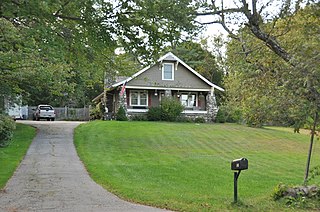
The Hartwell House is a historic house in Reading, Massachusetts. The 1+1⁄2-story wood-frame house was built in 1918 for George Hartwell, an engineer. The most prominent feature of this Craftsman/Bungalow style house is its stonework: the front porch is supported by tapering piers of fieldstone, and the full length of its chimney is similarly composed. There is a decorative woodwork trellis at the peak of the front gable.

The Roberts House is a historic house at 59 Prospect Street in Reading, Massachusetts. The two-story house is basically Colonial Revival in character, but also exhibits Craftsman style features, including extended eaves with exposed rafter ends, stucco walls, and a chunky entrance portico. The window above the entrance is a Shingle style band of three casement windows, and there is a hip-roof dormer in the roof above. The house is one of Reading's better examples of Craftsman architecture, and was built in 1911, during a building boom on the town's west side.

The House at 26 Francis Avenue in Wakefield, Massachusetts is a Colonial Revival octagon house. The shingle-clad wood-frame house rests on a high fieldstone foundation, is 2 stories at its rear and 1-1/2 in front, and has the appearance of a square house with four square sections projecting diagonally from each of its corners. The house has a Craftsman/Bungalow-style hip-roofed dormer with diamond-paned windows, and its main entrance is oriented diagonally toward the corner, under a porch supported by round columns.

The House at 18 Park Street, also known as the Clarence A. Van Derveer House, is a historic house at 18 Park Street in Wakefield, Massachusetts. The 1+1⁄2-story Craftsman/Bungalow style house was built in 1922 by Clarence A Van Derveer, a real estate broker who lived next door and subdivided his lot to build this house. It has classic Craftsman features, including exposed rafters under extended eaves, and paneled porch pillars and rails.

The Dr. Thomas Simpson House is a historic house at 114 Main Street in Wakefield, Massachusetts. It is a 2+1⁄2-story timber-frame house, in a local variant of Georgian style that is three bays wide and four deep, with a side gable roof. Its primary entrance, facing west toward Lake Quannapowitt, has sidelight windows and pilasters supporting an entablature, while a secondary south-facing entrance has the same styling, except with a transom window instead of sidelights. The core of this house was built by Dr. Thomas Simpson sometime before 1750, and has been added onto several times. It was restyled in the Federal period, when the door surrounds would have been added.
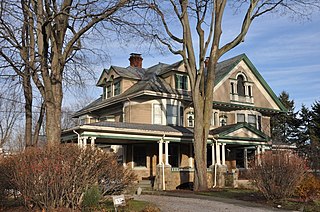
The Simpson House is a historic house at 57 Hunnewell Avenue in Newton, Massachusetts. The 2+1⁄2-story wood-frame house was built in the late 1890s, and is an excellent local example of a well-preserved Queen Anne Victorian with some Colonial Revival features. It has roughly rectangular massing, but is visually diverse, with a number of gables and projections. A single story porch across the front extends over the drive to form a porte cochere, and rests on fieldstone piers with Tuscan columns. The stairs to the entry are called out by a triangular pediment, above which is a Palladian window with flanking columns. Joseph Simpson, its first owner, was a principal in the Simpson Brothers paving company.
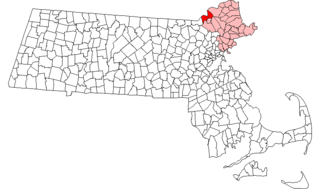
This is intended to be a complete list of the properties and districts on the National Register of Historic Places in Methuen, Massachusetts, United States. The locations of National Register properties and districts for which the latitude and longitude coordinates are included below, may be seen in an online map.

First Church Congregational is a historic church at Pleasant and Stevens Streets in Methuen, Massachusetts. The stone Gothic Revival structure was built in 1855 for Methuen's first congregation, established in 1729. Its first meeting house was on Daddy Frye's Hill, but moved to the present location in 1832. The present building features granite walls, a slate roof, and a tower with crenellated top and typical Gothic lancet windows. In 1895 the church installed a stained glass representation of Christ's Resurrection designed by John LaFarge.























